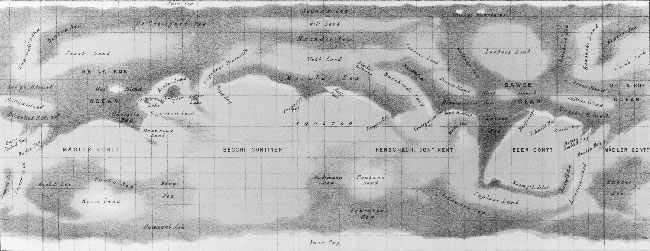"There is a general want of resemblance not easily explained, till, on careful comparison, we find that much may be due to the different principles on which the delineation was undertaken. Green, an accomplished master of form and colour, has given a portraiture, the resemblance of which as a whole, commends itself to every eye familiar with the original. The Italian professor, on the other hand, inconvenienced by colour-blindness, but of micrometric vision, commenced by actual measurement of sixty-two fundamental points, and carrying on his work with commendable pertinacity, has plotted a sharply-outlined chart ... his style ... as unpleasantly conventional as that of Green indicates the pencil of an artist; the one has produced a picture, the other a plan."

Barnard didn't see Mars as "flat or mappy" at all. He approached the planet as a landscape to be depicted, his mindset - as might be expected of someone who has been described as the Ansel Adams master-photographer of the Milky Way -- was that of the artist. His Mars was Green's, not a Schiaparelli's. Summarizing his observations of Mars from 1894, he wrote:
"Under the best conditions these dark regions, which are always shown with smaller telescopes as of nearly uniform shade, broke up into a vast amount of very fine details. I hardly know how to describe the appearance of these 'seas' under these conditions. To those, however, who have looked down upon a mountainous country from a considerable elevation, perhaps some conception of the appearance presented by these dark regions may be had. From what I know of the appearance of the country about Mount Hamilton as seen from the observatory, I can imagine that, as viewed from a very great elevation, this region, broken by canyon and slope and ridge, would look just like the surface of these Martian 'seas.'"
This perfectly captures, in our view, the approach needed to render the delicate surface of Mars. When presented with the sudden appearance of a feature at the threshold of vision, observers like Barnard also may have responded, at first, with "a line"; but they also had a sense of "yes, but...." The nineteenth century artist and art critic John Ruskin may provide the best commentary. The observers of Mars who provided the most accurate representations of the planet - those that came closest to the appearance that we saw presented to us night after night in the great telescope - were those whose practice approximated that suggested by Ruskin in *Modern Painters, volume IV, chapter 4 :
"Take the commonest, closest, most familiar thing, and strive to draw it verily as you see it. Be sure of this last fact, for otherwise you will find yourself continually drawing, not what you see, but what you know. "Try to draw a bank of grass, with all its blades; or a bush, with all its leaves; and you will soon begin to understand what a universal law of obscurity we live, and perceive that all distinct drawing must be bad drawing, and that nothing can be right, till it is unintelligible."
Mars was for two weeks our bank of grass, with all its blades, or bush with all its leaves, and we hope that if we have not quite succeeded in achieving good drawing, at least we have avoided bad drawing, in Ruskin's sense, which includes all those charts and diagrams of the canal school.